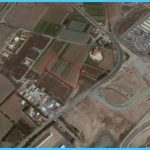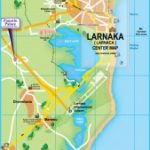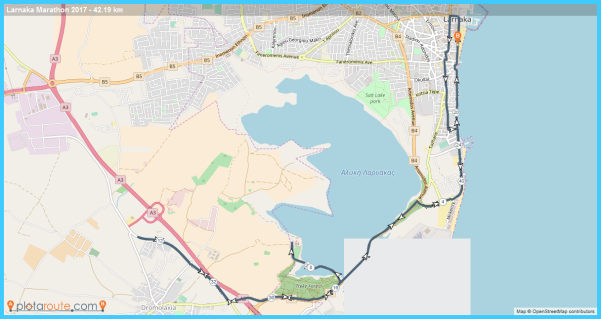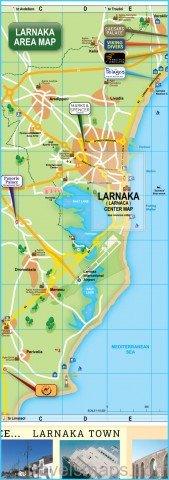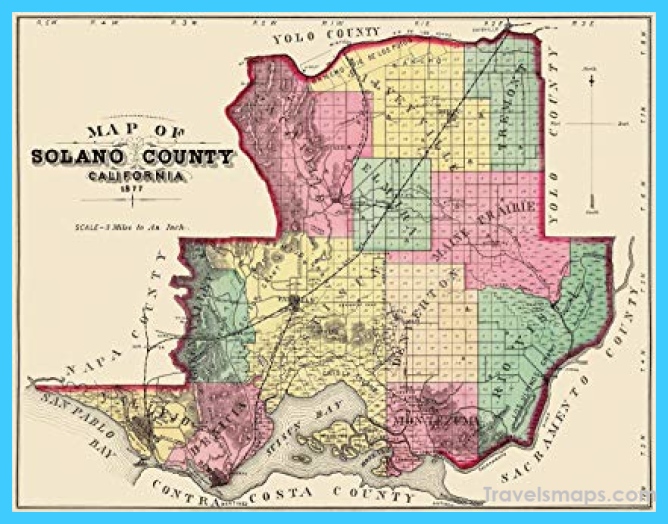
Artichoke cultivation at Dromolaxia
Dromolaxia, is very ancient, judging from the fact that Hala Sultan Tekke falls within its administrative boundaries. Machairas mentions the village, underlining that in 1425 it was burnt by the Saracens. The visitor to
Dromolaxia, apart from Kamares, the relics of the old aqueduct which conveyed water from the river Tremithos to Larnaka, will also see the church of Agios Ioannis the Baptist, built in the 18th century. Meneou. For centuries the plain of Meneou was cultivated with fruit and vegetables as today. In the past few years, houses have been constructed along the coast, either for rent or sale. Close to the new housing units stands the Maritime Experimental Station. Kiti is very old. Leontios Machairas, the chronicler, refers to Kiti by writing that king Peter I (1359 – 1369), arrived at Kiti, implying that a palace already existed in the village. The Saracens who invaded Cyprus in 1425, destroyed, among other villages, Kiti as well. Mariti, who visited Cyprus in the middle of the 18th century, refers to a well, located in the middle of the village as well as a fort, demolished later. Northwest of Kiti, on a very gentle rise, stands a very interesting church of Cyprus, the Byzantine Church of Panagia (Madonna) Angeloktisti (the Angel-built). According to tradition, if was built by Angels, who at midnight descended from the Heavens and built the church. Two important additions are noticeable in the south of the church: (a) A Frankish chapel of the 14th century, which once belonged to the medieval family of Gibelet. On the wall of the chapel are three coats of arms. The three lion’s heads is almost certainly the coat of arms of the important family of Gibelet (b) On the north side of the church a small dark chapel has been added, which, according to Jeffery, was a small mortuary chapel. The main church is three-aisled, built in the 11th century, on the foundations of an older Byzantine basilica. Dim traces of frescoes on the walls witness that most probably the church was originally entirely painted. However, the most glorious item to be seen in the church is the mosaic in the central apse, which shows the Madonna holding a Child. She stands between the Archangels Michail and Gabriel. Some support that the fifth or sixth century is a possible date of the mosaic. A centuries-old tree of terebinth, 14m high, stands to the east of the church, regarded as one of the oldest terebinth trees in Cyprus.
Panagia Angeloktisti, Kiti
Perivolia. A tourist village, known as Faros Village, was the nucleus for the subsequent development of other hotels and hotel apartments in the village. Currently, restaurants, souvenir shops, bars and many other shops function within the settlement. Among the cultural features of the village, the tower occupies a pre-eminent position. It is situated on an imposing hummock, about 500 metres from the sea, very near the cape and the lighthouse. The only opening is a rectangular window in the northern part, over which there is a Venetian coat of arms. A ladder is needed in order to enter the tower, similar to the ladder used in Venetian times when the tower was functioning. The building, eight meters high, consists of two storeys separated by a wooden floor. It seems that the guards spent most of their time on the upper floor. Most probably the first floor was used as a store or for other needs. Close to the tower stands a lighthouse, 22m high. Besides, on the periphery of the settlement stands the vaulted church of Agios Leontios, a building of the 18th century.
Map of Dromolaxia Dromolaxia Map Photo Gallery
Venetian tower (Perivolia)
Tersefanou possesses many churches, old and modern, worth seeing. The modern church of Agios Ektarios, completed in 1985, impresses with its modern iconostasis and the paintings in the sanctum. East of Agios Ektarios, stands the old church of Agia Marina, built in the 17th century, obviously founded on an older Latin church. It is surrounded by pillars and capitals scattered around, while in a corner of the church a coat of arms of Saint Mark of Venice is kept. Another coat of arms lies above the window, east of the sanctum. The most precious treasure of the church, however, is the old gilted iconostasis with portable icons, that date back to the 16th and 18th centuries. The vaulted church of Agios Georgios of the River, east of the village, a building of the 16th century, in its present appearance has nothing with which to impress. About a mile and a half from the village is the church of Agios Georgios of Arpera, built in 1736. Most probably it is built on the foundations of an older church. There are a number of paintings in the interior of the church, the most important of which is that of Christofanis, the donor. The dresses show marked Turkish influence and the painting gives in great detail the costumes worn by Cypriots in the middle of the eighteenth century. Close to the church of Agios Georgios of Arpera is the dam of Tersefanou, constructed on the river Tremithos. Softades village is abandoned since 1975. Kivisili, though a Turkish-Cypriot settlement, contains a small domed church in the Byzantine style, dedicated to Panagia Eleousa. According to Gunnis, the church was originally Latin. One of the steps in front of the 18th century iconostasis is formed by a medieval tombstone with an inscription in Gothic script beginning “Ici git”, although the rest of the inscription is illegible. Mazotos. The church of Panagia, close to the cape of Petounta is rain-bearing. When drought is prolonged, people carry the icon and pray to God for rain. Close to the domed church of Panagia, a modern chapel has recently been built. The church of Agios Xenofon impresses with the large number of waxen effigies which are offerings of pious Christians from many parts of Cyprus. According to Hill, the well-known Roman road passed through Mazotos, and according to the milestones found, of the 4th century A.D., it followed the present earthen coastal road. This road, which currently can be traversed by special vehicles, offers pictures of rare aesthetic value. Petounta offers a vast view north-east and southwest. The extensive beach of the village, and the tranquil environment are promising factors for the development of tourism in the village. A camel park with over 30 camels functions for tourist purposes. Alaminos. Alaminos tower, now restored, is part of the tower-network between Xylofagou and Alaminos. It is nine metres high, with simple features and with an entrance that leads to the first floor, while the windows are on the second floor. The narrow, elongated skylights are present on all sides of the building. It is a Venetian tower, built in the 15th century. The inhabitants of the village speak of a tunnel which linked the lower part of the tower with the settlement. This tunnel was functioning, according to local information, even as late as 60 years ago. The church of Agios Mamas is another interesting feature of the village once completely painted, though most of the paintings have been whitewashed. Anafotida. The village church is dedicated to Agia Fotini, dating back to 1743. Aplanta is currently abandoned by its inhabitants.
Vavatsinia village
Visit to the mountain villages via Lefkara Route: Vavatsinia, Agioi Vavatsinias, Odou, Melini, Ora, Lageia, Vavla, Parsata, Drapeia Vavatsinia. One can approach the picturesque village of Vavatsinia from the Skarinou-Lefkara road. The medieval church dedicated to the Virgin Mary is worth visiting. The church has a wooden roof, it is arched and single-aisled, with new beams replacing the original ones. The gilted iconostasis is worth noting, as are its bas-reliefs and several old icons. The church was reconstructed in 1780. Agioi Vavatsinias. Near the center of the village, one comes across the village church, dedicated to Agioi Kosmas and Damianos, erected in 1871, probably upon the foundations of an older, smaller church.
Church of Panagia Chryseleousa, Melini
Vavla
The carved 19th century oak iconostasis, strikingly brown in colour, fascinates the visitor. Of particular interest in the church is an Italian chair, dating back to the 16th century. Somewhat outside the village, one can visit the holy well where, according to tradition, Agioi Kosmas and Damianos used to water their horses. The villagers believe that this water has healing qualities. A stroll along the narrow alleys of the village allows the visitor to have a close look at the many and unpretentious stills in which “zivania”, a local alcohol, is prepared. The village is renowned for its silver and lace-work, even though many people are not familiar with this aspect. The small dam was recently constructed to the south-west of the village. Odou. The village of Odou can be described as a botanical garden, possessing a rich flora. Neither, though, does the fauna lack in any respect. A location near the village, Chelidonomoutti”, is the home of swallows during a large part of the year. Nightingales sing in the valley near the village well. Feral cats roam the isolated and steep slopes of the mountainous landscape and almost all kinds of Cypriot serpents have found their ideal habitat here. Traditional architeture abounds in the village, in particular around the huge, centuries-old nettle-tree. The church of Odou, dedicated to Agia Marina, was built in 1777 and features an even older gilt iconostasis. The church has a steep-pitched roof supported by wooden beams. Melini. This small village, is mentioned in relation to the life of Saint Irakleidios, a fact which leads to the conclusion that the village was a substantial settlement during the 1st century A.D. It seems that the saint, en route from Kourio to Tamassos, following the shortest route, via Mathikoloni, passed through Melini, which he mentions in his writings. The church of Panagia Chryseleousa, built in 1721 possibly on older foundations, has a steep-pitched roof and is single-aisled with a gilt iconostasis and carved beams. Ora. A wealthy emigre from Ora founded, as early as 1863, the “Oratios” school, still functioning in the village. The village is continuously improving its agricultural activities, thanks to an earthen reservoir built recently. The “Ora” table water is sold throughout Cyprus as well as abroad. Lageia. The village is declining in population despite its rich flora and fauna and its beautiful and picturesque landscape. Vavla. With the exception of the few cultivated tracts of land, the largest part of the landscape of Vavla is covered with a rich natural flora. The women of Vavla, as is the case with the women of all the neighbouring villages, occupy themselves with embroidery for years now. Vavla possesses a history that reaches back many years. British architect Jeffery notes that, during the 14th century, the Dominican Knights ruled over the monastery of Agios Epifanios which, in 1461 became the property of the Constanzo family. Sadly, however, no traces of this monastery survive in Vavla today. Parsata & Drapeia, are two deserted villages.
Maybe You Like Them Too
- The Best Places To Visit In North America For Christmas
- Faro Travel Guide: Map of Faro
- Mumbai Travel Guide For Tourists: Map Of Mumbai
- Travel to Budapest
- Thailand Travel Guide for Tourists: The Ultimate Thailand Map


